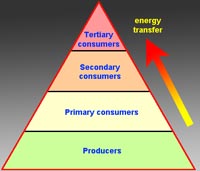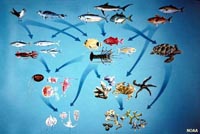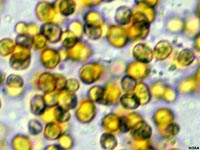13.2: Trophic Pyramids
- Page ID
- 10350
Trophic Pyramids
A trophic pyramid exemplifies feeding levels within an ecosystem.

There are three major categories of living organisms in an ecosystem and each has a special role: producers (plants), consumers (animals), and decomposers (and detritus feeders).
| Tropic Levels | Organisms |
| Tertiary consumers | carnivores (larger animals, i.e. tuna, sharks, birds, sea mammals, etc.) |
| Secondary consumers | carnivores and detritus feeders (i.e., small fish, crustaceans) |
| Primary consumers | herbivores (zooplankton) |
| Primary producers | photosynthetic bacterial - plankton - plants (focus of this chapter) |
A “food chain” is a hierarchical series of organisms each dependent on the next as a source of food.
A “food web” is a system of interlocking and interdependent food chains.
Note: food chains range from simple to complex! For instance, larvae of some organisms may start as primary consumers but rise to secondary levels as they mature

All living things rely on the continual uptake of organic compounds from their environment. These compounds are used to provide energy both for biosynthesis (the production of a chemical compounds by a living organism) and metabolism (the processes that drives cellular activity and to generate carbonate skeletons).
The first organisms on the primitive Earth had access to an abundance of the organic compounds in the young oceans and continents. However, most of these original compounds were used up billions of years ago. Through evolution over time, today, the vast majority of the organic materials required by living cells are produced by photosynthetic organisms, including many types of photosynthetic bacteria, green algae, and plants.



